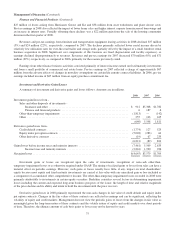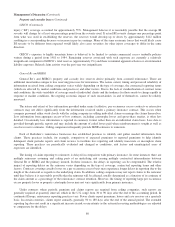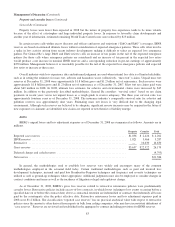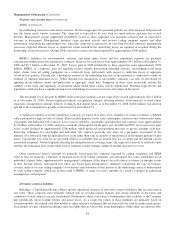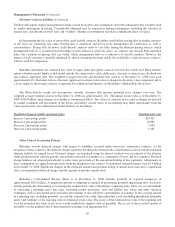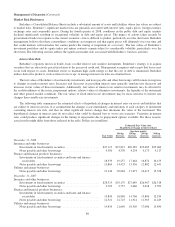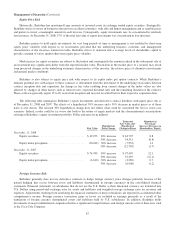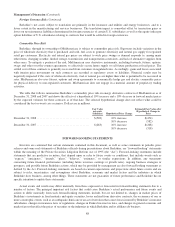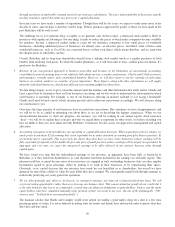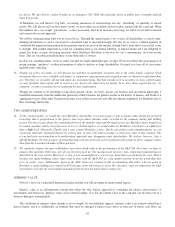Berkshire Hathaway 2008 Annual Report Download - page 84
Download and view the complete annual report
Please find page 84 of the 2008 Berkshire Hathaway annual report below. You can navigate through the pages in the report by either clicking on the pages listed below, or by using the keyword search tool below to find specific information within the annual report.Management’s Discussion (Continued)
Property and casualty losses (Continued)
General Re (Continued)
Actuaries classify all loss and premium data into segments (“reserve cells”) primarily based on product (e.g., treaty,
facultative and program) and line of business (e.g., auto liability, property, etc.). For each reserve cell, premiums and losses are
aggregated by accident year, policy year or underwriting year (depending on client reporting practices) and analyzed over time.
These loss aggregations are internally called loss triangles which serve as the primary basis for IBNR reserve calculations. Over
300 reserve cells are reviewed for North American business and approximately 900 reserve cells are reviewed with respect to
international business.
Loss triangles are used to determine the expected case loss emergence patterns for most coverages and, in conjunction with
expected loss ratios by accident year, are further used to determine IBNR reserves. Additional calculations form the basis for
estimating the expected loss emergence pattern. The determination of the expected loss emergence pattern is not strictly a
mechanical process. In instances where the historical loss data is insufficient, estimation formulas are used along with reliance
on other loss triangles and judgment. Factors affecting loss development triangles include but are not limited to the following:
changes in client claims practices, changes in claim examiners’ use of ACRs or the frequency of client company claim reviews,
changes in policy terms and coverage (such as client loss retention levels and occurrence and aggregate policy limits), changes
in loss trends and changes in legal trends that result in unanticipated losses, as well as other sources of statistical variability.
These factors influence the selection of the expected loss emergence patterns.
Expected loss ratios are selected by reserve cell, by accident year, based upon reviewing forecasted losses and indicated
ultimate loss ratios that are predicted from aggregated pricing statistics. Indicated ultimate loss ratios are calculated using the
selected loss emergence pattern, reported losses and earned premium. If the selected emergence pattern is not accurate, then the
indicated ultimate loss ratios will not be accurate and this can affect the selected loss ratios and hence the IBNR reserve. As
with selected loss emergence patterns, selecting expected loss ratios is not a strictly mechanical process and judgment is used in
the analysis of indicated ultimate loss ratios and department pricing loss ratios.
IBNR reserves are estimated by reserve cell, by accident year, using the expected loss emergence patterns and the expected
loss ratios. The expected loss emergence patterns and expected loss ratios are the critical IBNR reserving assumptions and are
updated annually. Once the annual IBNR reserves are determined, actuaries calculate expected case loss emergence for the
upcoming calendar year. This calculation does not involve new assumptions and uses the prior year-end expected loss
emergence patterns and expected loss ratios. The expected losses are then allocated into interim estimates that are compared to
actual reported losses in the subsequent year. This comparison provides a test of the adequacy of prior year-end IBNR reserves
and forms the basis for possibly changing IBNR reserve assumptions during the course of the year.
In 2008, for prior years’ workers’ compensation losses, reported claims were less than expected claims by about $93
million. However, further analysis of the workers’ compensation reserve cells by segment indicated the need for additional
IBNR. These developments precipitated about $116 million of a net increase in nominal IBNR reserve estimates for unreported
occurrences. After deducting $117 million for the change in net reserve discounts during the year, workers’ compensation losses
from prior years reduced pre-tax earnings in 2008 by $140 million. To illustrate the sensitivity of changes in expected loss
emergence patterns and expected loss ratios for General Re’s significant excess-of-loss workers’ compensation reserve cells, an
increase of ten points in the tail of the expected emergence pattern and an increase of ten percent in the expected loss ratios
would produce a net increase in nominal IBNR reserves of approximately $623 million and $339 million on a discounted basis
as of December 31, 2008. The increase in discounted reserves would produce a corresponding decrease in pre-tax earnings.
Management believes it is reasonably possible for the tail of the expected loss emergence patterns and expected loss ratios to
increase at these rates.
Other casualty and general liability reported losses (excluding mass tort losses) were favorable in 2008 relative to
expectations. Casualty losses tend to be long-tail and it should not be assumed that favorable loss experience in a year means
that loss reserve amounts currently established will continue to develop favorably. For General Re’s significant other casualty
and general liability reserve cells (including medical malpractice, umbrella, auto and general liability), an increase of five points
in the tails of the expected emergence patterns and an increase of five percent in expected loss ratios (one percent for large
international proportional reserve cells) would produce a net increase in nominal IBNR reserves and a corresponding reduction
in pre-tax earnings of approximately $805 million. Management believes it is reasonably possible for the tail of the expected
loss emergence patterns and expected loss ratios to increase at these rates in any of the individual aforementioned reserve cells.
However, given the diversification in worldwide business, more likely outcomes are believed to be less than $805 million.
82





